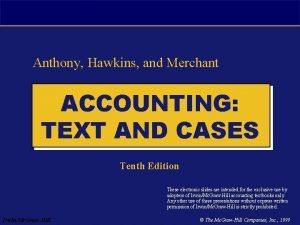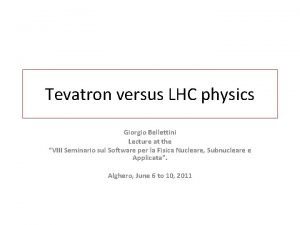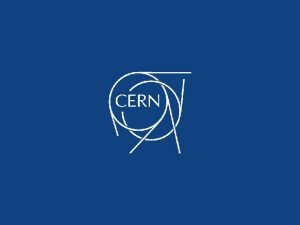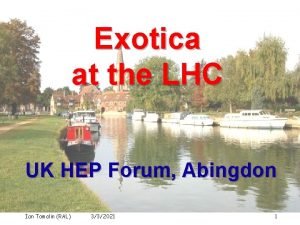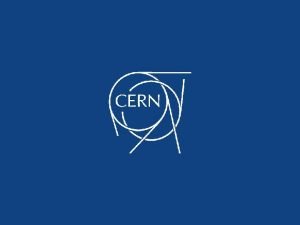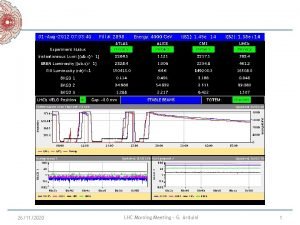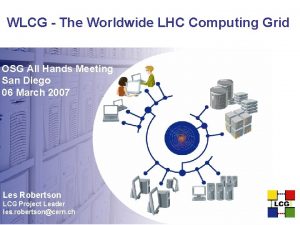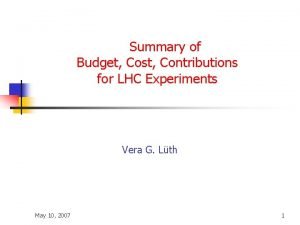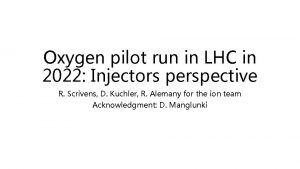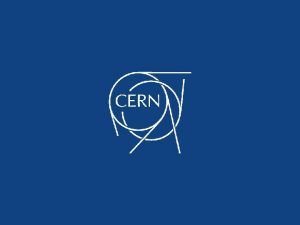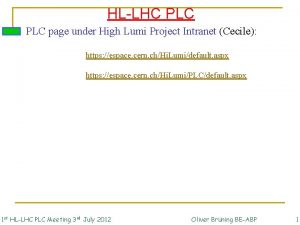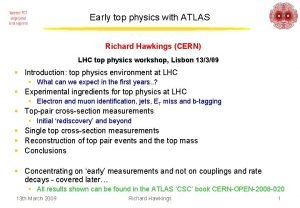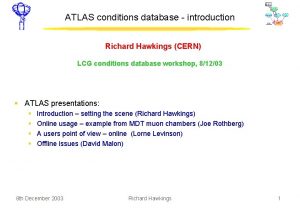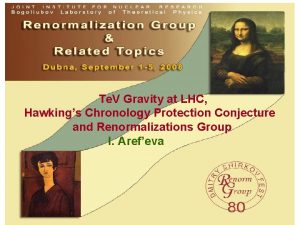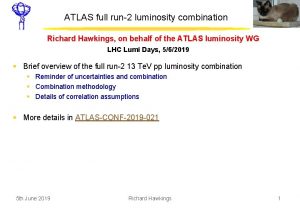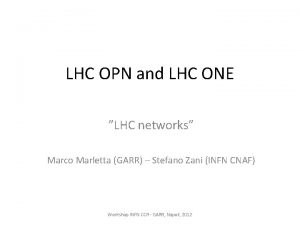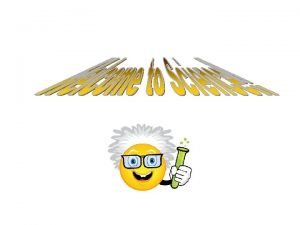Top properties measurements at LHC Richard Hawkings CERN














- Slides: 14

Top properties measurements at LHC Richard Hawkings (CERN) London Standard Model discovery workshop, UCL 31/3/09 § Introduction/motivation § Top quark charge § t-tbar spin correlations § W polarisation and the Wtb vertex § Summary / outlook § § § ATLAS results from CERN-OPEN-2008 -20 (‘CSC book’) CMS results from CMS Physics TDR Some Tevatron results for comparison… 31 st March 2009 Richard Hawkings 1

Why measure top properties at the LHC? § Top exists! Measure its fundamental parameters (mass, charge, couplings, …) § Heaviest known quark, least studied, some peculiar properties § Decays involve real rather than virtual W § Decays before hadronises – spin/polarisation information is preserved § Top quark beyond the Standard Model § Top may be produced in new particle decays (t-tbar resonances, heavy H …) § Top quarks may decay in peculiar ways, e. g. t H+b § Careful measurement of the top quark properties may reveal deviations from the SM expectation, signaling new physics § LHC is a top quark factory § At 1033 cm-2 s-1 (‘nominal’ low luminosity), get 1 top pair/second, or 8 M/year § 30% of these decay to {e/ } b jjb or {e/ } b final states, good trigger efficiency § At 1034 cm-2 s-1 (full LHC design luminosity before SLHC upgrade), get 10 Hz top pairs … O(100 M)/year § But background from pileup at 1034 will make precision studies difficult § Analyses of top properties concentrate on 1033 scenario (and 14 Te. V Ecm) 31 st March 2009 Richard Hawkings 2

Top quark charge - SM or exotic? § Object with mass 173 Ge. V, decays to Wb W+ t b +1 +2/3 -1/3 W+ ? b/b-bar jet charge in top Monte Carlo b +1 +4/3 +1/3 § Some scenarios with an exotic 4/3 e charge object at 175 Ge. V, real mtop>230 Ge. V § Measure the top charge (its decay products) § Charge of the lepton ( 1) charge of W § Charge of the b-quark ( 2/3) … infer from jet charge of the b-jet D 0 jet charge with tagged di-jet data PRL 98 041801 § Technique familiar from B-oscillation and CPviolation studies, e. g. § Qjet= (ptrk pjet) Qtrk / (ptrk pjet) with optimised to give best b / b-bar separation § Challenges are to calibrate jet charge (from bflavour enhanced dijet data) and pair the lepton(s) and b-jet(s) correctly 31 st March 2009 Richard Hawkings 3

Top charge - Tevatron results § Tevatron stat-limited results: 16 events, 32 measurements 199 (l+jets) and 26 (ll) measm § D 0+CDF using l+jet events § B-tagging to identify b-jets § Association to correct lepton using kinematic fit of t-tbar § CDF also using dileptons § No b-tagging, use M(bl) of different assignments to determine correct ones § Both favour SM scenario § D 0 excludes that whole sample is exotic at 92% CL § CDF excludes same at 87%, with a 1% prob to falsely reject SM… different interpretation § D 0 fexotic<0. 8 at 90% CL § CDF fexotic<0. 6 at 95% CL § SM highly favoured over XM 31 st March 2009 1 -fexotic PRL 98 041801 Richard Hawkings CDF note 8967 4

Top charge measurement at LHC § Statistics good (~6000 l-jet pairs per fb-1) Qtop=Qjet*Cb+Ql § Simple selection, require two b-tags in event § Using l-bjet pairing based on M(lb) cuts, with 30% efficiency and 86% correct pairing fraction § Simple Qjet with =0. 5; 2 tracks p. T>1. 5 Ge. V § Can also use b-jets with muons to get Qb § Measure Qcomb=Qjet*Ql and Qtop=Qjet*Cb+Ql § Cb calibrates jet charge: Qb=Qjet*Cb § Expect Qcomb<0 with 20 statistical in 1 fb-1 § Systematics for Qcomb (%) Q(jet) 31 st March 2009 muon Charge of muon in b(Qb=-1/3)-jet § Largely data-driven - e. g. understanding of non-ttbar background § Eventually use tagged di-jet data to measure Qjet performance (Cb) with data § Will be sensitive to mixture of SM and XM scenarios … Richard Hawkings 5

Top-anti-top spin correlations § Top quarks produced ~unpolarized in SM § But spin of t and t-bar are correlated - depends on production mechanism (qq vs gg) and energy § Measuring spin correlation gives info on production § Parameterise with an asymmetry A § Since top decays before hadronisation, spin information is preserved in decay product angles • Can also look at opening angle § Angle defined between top quark direction in ttbar rest frame, and decay product in t rest frame • Useful in particular for dileptons § 1, 2 measured using a decay product from each top quark 1, 2; 1, 2 are analysing powers § : Correlation between top and decay product § 1 for lepton; -0. 41 for b, 0. 51 for lower E q from W 31 st March 2009 Richard Hawkings 6

Angular reconstruction § Experimentally, choose two ‘analyser particles’ § E. g. lepton and lower-energy quark from W decay § Need to fully reconstruct event (t/tbar 4 -vectors) Generator-level CMS § Including estimate of neutrino from missing ET vector § Typically require lepton+≥ 4 jets, 2 -b-tagged jets, using mass requirements and/or kinematic fits to ensure good event reconstruction § CMS study shows S/B of 4. 5, background dominated by mis-reconstructed top decays § Expect around 10 k reconstructed events per fb-1 @ 14 Te. V § Resolution and acceptance effects modify the expected distributions § Correct using a 6 x 6 matrix (CMS approach) CMS Resolution Reconstructed CMS § Ratio of reconstructed to selected events in each bin § Background must also be subtracted … then fit distribution according to 31 st March 2009 Richard Hawkings 7

Angular reconstruction and results § Alternative approach based on means (ATLAS) § Means of cos 1 cos 2 and cos distributions are estimators of A and AD § Make 1 D-distributions and correct bin-by-bin back to generator level to extract spin correlation Reconstructed, corrected to generator level cos 1 cos 2 § Estimated statistical/systematic uncertainties Expt Measurement Int L stat syst ATLAS A(q-l) 0. 42 1 fb-1 0. 17 0. 18 ATLAS AD(q-l) -0. 29 1 fb-1 0. 11 0. 09 CMS A(b-l) 10 fb-1 0. 027 0. 076 CMS A(q-l) 10 fb-1 0. 021 0. 041 § Require O(10 fb-1) to make clear 5 observation § Good control of systematics will be essential cos § B-tagging efficiency, jet energy scale, ISR/FSR … § Need time and data to understand t-tbar reconstrn 31 st March 2009 Richard Hawkings 8

W polarisation in top quark decays § W in top decay produced with different helicities F 0: W+ -1/2 FR: W+ +1 0 FL: b +1/2 t W+ +1 FR 0 only if mb>0 t +1/2 b -1/2 § Can be measured using the angle l* § Angle between W in top frame and lepton in W frame § In SM, F 0 0. 695, FL 0. 305, FR 0. 001 § Driven by mt/m. W and V-A structure of weak interaction § Extensions to SM can result in enhanced FL and/or FR § Attempt to reconstruct the cos l* distribution and fit the fractions of longitudinal, left and right polarised W 31 st March 2009 Richard Hawkings 9

W polarisation studies at the Tevatron § Various methods used to measure W polarisation § Reconstruction of cos l* (extract l+jets F 0 and FR) § Needs full event reconstruction, including missing ET § As for spin correlations, can fit reconstructed cos l* distribution to Monte Carlo templates for F 0, FL, FR, or correct for detector effects and fit at ‘generator’ level PRL 100 062004 § Measurements done with l+jets and dilepton events dilepton § Some ‘marginal’ consistency (2 -3 ) between channels (in both CDF and D 0) § Can also use jet from hadronic W boson decay measure |cos *| - information on F 0 § Other techniques used to avoid using missing ET § Charged lepton p. T spectrum and mlb have sensitivity to the FR fraction - difficult to fit all simultaneously § Full ‘matrix element’ fit as used for the top mass, varying F 0 with FR fixed to zero PRL 98 072001 CDF l+jets, 1 b-tag § Samples typically O(100 s) events - limited statistics § Systematics dominated by signal/bkg modelling 31 st March 2009 Richard Hawkings 10

W polarisation studies at LHC § Studies concentrated on the cos l* method § ATLAS - combined analysis with spin correlations § Select events with lepton + 4 jets and missing ET, with two jets b-tagged § Expect around 10 k events per fb-1 Correction function (from fast simulation) § Main background from t-tbar decays involving (around 10%); single top and W+jets < 5% § Reconstruct cos l* distribution and correct back to ‘generator’ level with correction weight function § Exclude extremes of distribution where correction is largest § Uncertainty / control of correction function is significant source of systematics § Also exploring template-based methods to perform fit directly to reconstructed distributions § With enough statistics, can extract F 0 and FR § And hence FL via F 0+FL+FR=1 31 st March 2009 Richard Hawkings Reconstructed and corrected cos l* 11

W polarisation results and prospects D 0 note 5722 § Some representative results and expectations F 0 § Using cos l*, other methods also used Expt fb-1 F 0 CDF lj 1. 9 0. 16 0. 07 D 0 lj+ll 2. 7 0. 11 0. 09 0. 06 0. 05 ATLAS lj 1 0. 02 0. 03 CMS lj 0. 02 10 FL FR 0. 04 0. 03 Physicallyallowed region 0. 02 § Tevatron results already providing significant constraints … but statistics limited § LHC should give precision measurements (in particular for FR ) § Ultimate precision will depend on careful control of systematics 31 st March 2009 95% CL Richard Hawkings FR CDF note 9215 F 0 F 12 R

Wtb vertex anomalous couplings § More general parameterisation of Wtb vertex: § Anomalous couplings sensitive to ratios L, R=FL, R/F 0 § Can also study asymmetries in the cos l* distribution, AFB, A+ and A§ Each asymmetry insensitive to one parameter F 0, FL, FR § Measure using corrected cos l* distribution in 1 fb-1 of ATLAS l+jet events; statistical and systematic errors: L R AFB A+ A- No b-tag 0. 05 0. 27 0. 008 0. 017 0. 025 0. 080 0. 024 0. 074 0. 012 0. 021 b-tag 0. 05 0. 16 0. 007 0. 012 0. 026 0. 033 0. 028 0. 052 0. 014 0. 027 § B-tagging helps reduce systematic errors Also limits for g. L vs g. R § Combined fit for couplings, eventually also include s/t channel single top x-sec 31 st March 2009 Richard Hawkings 13

Summary and outlook § The LHC ‘top factory’ offers an excellent opportunity for precision studies of top quark properties § Comprehensively exclude the q=4/3 e exotic ‘top quark’ with < 1 fb-1 § Sensitivity to small add-mixtures of exotic states as the luminosity increases § Studies of top spin correlations and the Wtb vertex require good detector understanding and 1 -10 fb-1 to reach maturity § With O(1 fb-1), can substantially improve on Tevatron constraints on W polarisation § Start to measure more parameters, add in constraints from single top § Will need > 1 fb-1 to make unambiguous observation of t-tbar spin correlations § Most of these studies require full reconstruction of t-tbar final state § Can start to refine techniques, understand resolution and systematics as soon as a significant sample of t-tbar events is recorded and isolated § Can also greatly benefit from large samples of e. g. Z events for calibration purposes § 100 -200 pb-1 data is certainly enough to make good progress - first year of data will be very valuable § … Top properties studies can start from the beginning of LHC data taking 31 st March 2009 Richard Hawkings 14
